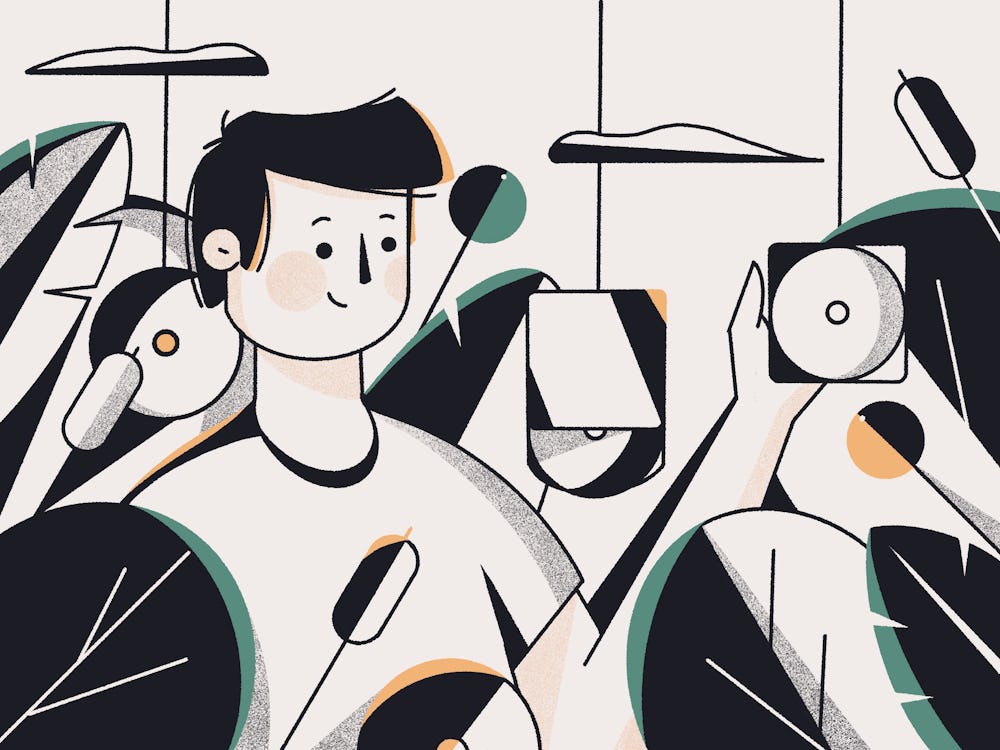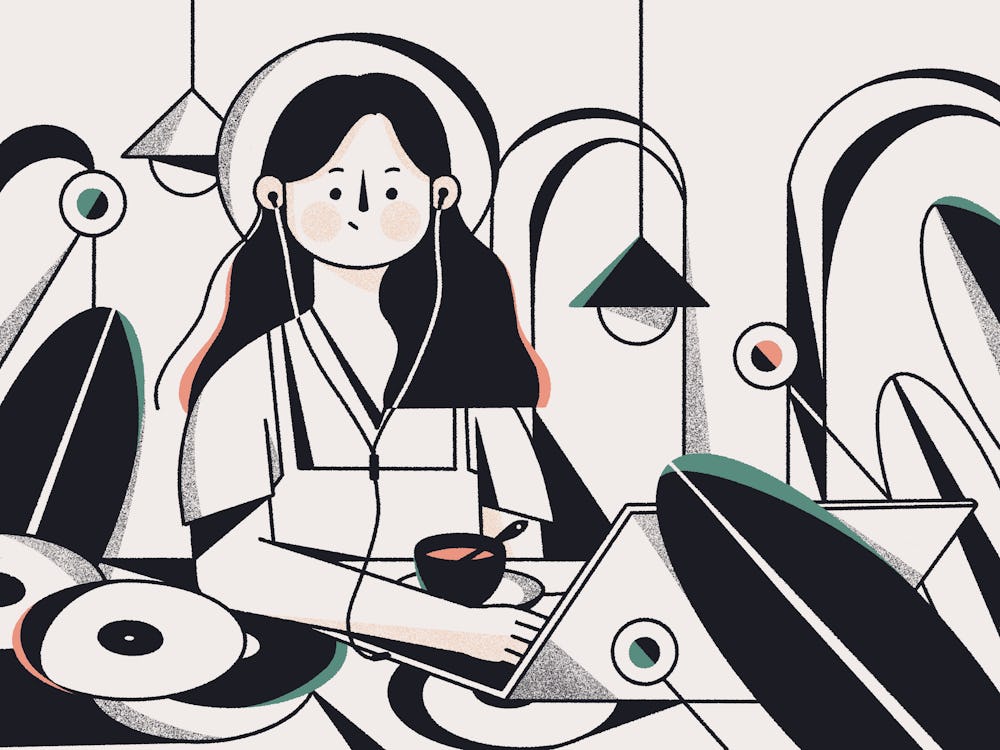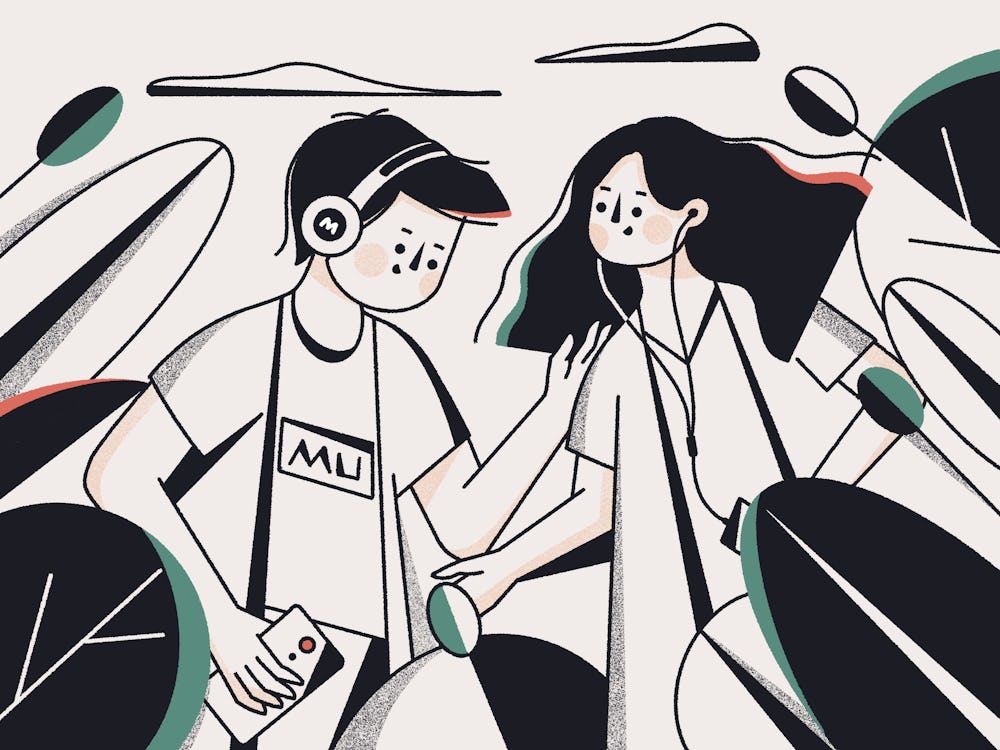September 2020
In the days before the internet was fast, I was a music fan with a plan. As a teenager, I had a collection of perhaps a hundred compact discs, and assumed it would soon be two or three. Buying music after school on the advice of peers who seemed to know what was hot, I usually listened to each album a couple of times straight through on my stereo before moving to the computer and beginning the lossless ripping ceremony.

The idea of creating and curating a music collection made sense. The goal was to grow and prune it like a garden, all the while enjoying raw sound, learning about the world, swapping albums with friends, and being inspired to create art of my own. And like any good hobby, it had a certain cadence, fixed by the cost of acquisition and the time available to hear about new stuff.
The combination of a shelf full of discs and an iTunes library was a good one. The shelf provided the rich artwork and effortless browsing of a traditional record collection — albeit at a much smaller size and diminished by compact discs’ hideous jewel case design. The computer enabled instant search, playlists, endless remixing, and, later, iPod playback.
In the early noughties, software didn’t change and break all that rapidly. Time spent using something like iTunes to, say, add five-star ratings to all your songs and create smart playlists mixing rating, genre, and release date, seemed like time well spent. Despite personal computers’ slowness and expensive storage, the endeavor was worthwhile. The digital side of music collecting was a neat extension of the physical.
Surprise
But some way into the streaming revolution, I stopped buying discs. It seemed like a waste of money. The move to subscription services was a real shock to the system, and for a long time it altogether killed my enthusiasm for finding and listening to new music. The abundance of an infinite library was like reaching middle age and starting to buy all the gadgets you could never afford when you were younger, having little or no time to actually use them. And worse, realising that much of the enjoyment had really been in the anticipation — in thumbing through catalogues, in pouring over technical specs, and in rumours about next year’s models.
“The move to subscription services was a real shock to the system”
I’ve mostly gotten used to it. Over the past decade as mobile and home internet have improved, streaming music has come a long way. I love some of the features the modern apps make possible, such as a home filled with network speakers, painstakingly hard-wired through plaster and joist for minimum latency and robust sync, that supply a lush soundtrack to any activity. And a few years in, I’m listening to more new music, which — assuming I can find it again later — is a good thing. But the experience is still missing a piece.
Tools of Engagement
No shortage of opinion exists on what was lost during the previous major format transition from records to discs. Audio quality improved at the cost of that of artwork. Shuffle arrived at the expense of an artist’s vision for their complete album. Longevity increased one hundredfold, while each listen became less valuable. The common thread is that the process of engagement with the art changed. A process previously bounded — to its benefit — by the physical limits of acquisition and playback.
Our present transition takes things to their logical end point. The art is completely accessible, the methods of discovery and engagement completely digital. In fact, discovery isn’t half bad, with all the major players offering a broad weekly lineup of preset and algorithmically-generated content. A little sterile, perhaps, compared to huddling with friends around the new music section of a decent record store, desperately scanning for the latest Dream Theater release, but novel and usable. Engagement, though, is still shallow at best.

Likes, ratings, playlists, and sharing are all fine features, but they do not compare to the shelf. The immediate problem is that as the humble user of someone else’s service, you’re not in control of when these features appear and disappear, nor how they’re presented from one software release to the next. My current app of choice, Apple’s Music, has played around with ratings a few times, eventually moving traditional five-star rating controls out to secondary screens and bringing in new ‘love’ and ‘dislike’ buttons. Another casualty is the checkbox that then-iTunes used to show for every track, denoting whether a song would be skipped during normal playback. I used to use this feature all the time to customise my album playback experience, cutting out an intro skit here, or a filler track or artist interview there. It’s also still available in a submenu (bafflingly titled ‘untick selection’), but for how long? Who knows.
I don’t blame anybody. Software moves fast, and I do my share of the moving. But I’ve developed a keen aversion to investing time tending metadata in library systems like this. It’s a lesson in software rot that I originally learned — most painfully — in the case of photography, wherein my current library has been migrated through at least three different apps, and now contains fifteen years of only mostly-not-corrupted images with barely any remaining historic album, rating, or editing metadata. And besides the concern of incidental data loss, the competitive market means each month also brings some chance that a competing service’s offer will be worth ditching your entire investment anyway.
“Software moves fast, and I do my share of the moving”
Granted, some of this stuff borders on niche interest. I realise that not everybody cares whether their likes and ratings persist beyond next month, let alone next year. But the heart wants what the heart wants. And sometimes the heart wants unfettered access to a decade of well-maintained music metadata to check the play count on some Steely Dan tracks. For a more mainstream angle on how much the average listener uses likes and other engagement features, consider the multiple, predictable failures of Apple’s social music effort, which saw both Ping and Connect petering out to nothing barely weeks after launch.
My issues with playlists as an engagement feature tend more towards indifference. While they’re barely changed from what I used happily enough in early versions of iTunes, nowadays I find myself mainly playing tracks from apps’ recently added sections over and over, or searching directly for classic albums I can easily bring to mind — rarely do I browse my old playlists or make any new ones. Before, I wasn’t so worried about the software changing unexpectedly, or about losing data after a library migration or two. And I also often burned playlists to disc, scribbled on them, and carried them around town in a wallet. Which was, well, way more fun!
But why was it more fun? Herein lies our missing piece. Take a moment to recall and admire the artefacts of the old world of physical media: a colourful wall of records; a cheeky birthday mixtape; a wallet packed with old road trip discs. They’re all things that listeners made using the original art. Our current crop of music apps are slick and laden with features, but you don’t get to create anything.
“Our current crop of music apps are slick and laden with features, but you don’t get to create anything”
One reason for this is that these platforms are just so big now, and have to appeal to a plethora of different use cases. All the features tend to converge on the lowest-common-denominator passive consumption use case, and little space is left for anything too interesting or effortful that risks scaring off the casual listener. I don’t mean to pooh-pooh this core experience. It’s amazing that anyone with access to a device and monthly cash on the same order as a mobile phone contract now has easy access to almost the entire history of recorded music, and scores of product designers and developers toil to make it happen. It’s just that the core experience is about all there is.
Thinking again on my old collecting and curation habits through the lens of modern user-centred design, I suppose my being an avid disc buyer and a burgeoning metadata junkie did put me well outside the handful of common, more passive, use cases right from the beginning. Back then, the products (discs and tapes), and tools (playback hardware and music software) were much more loosely coupled and open for access. If you were inclined to play around with these pieces, the price of entry really wasn’t too high. From the enterprising kid recording radio tunes onto cassettes and adding their own voiceover for a toy programme, to the devoted analogue enthusiast, transforming their spare room into a dazzling music den lined with 45s, there was a lot on the table. Now, everything is so centralised and tightly integrated that it’s far harder to break out from passive listening, and use the supplied media in a novel way. What can we do to bring a bit more creativity and joy to the digital music experience?
Creativity & Joy
You can certainly continue, or get back to, collecting physical media alongside listening online, as many have during the much-reported vinyl revival of the past few years. That’s an interesting space, especially on the business end, with some artists now charging a premium for physical products that might actually come somewhere close to paying for their labour. It’s not for me, though. I want to see the next stage in digital.

I think the only way forward is for independent designers, developers, and teams to build simple, focused apps that sit on top of the major streaming services, treating the platforms as infrastructure using what we call APIs. This is nowhere close to being a new idea, but I’m always surprised at how few novel music player apps show up when you search the app stores. Most of the results are just clones of the system music players, and don’t deliver anything new. It is notable how many really high quality music production apps exist, especially on mobile, but that’s a specialist area driven by its own market. DJ apps sit somewhere in the middle, and those that pull music in from streaming services are a great example of the general approach. While still fairly specialised, they provide exactly the kind of creative layer that brings some of our former joy back to digital.
With a diverse enough lineup of accessible third-party music apps, and by putting some real thought into how apps’ content might interact and combine in an increasingly open and community-spirited way, I think we can place the missing piece. It might have taken a few years, but I think I’ve finally got my head around the streaming music experience, started to actually enjoy it, and figured out what more I want. It’s time to build something.